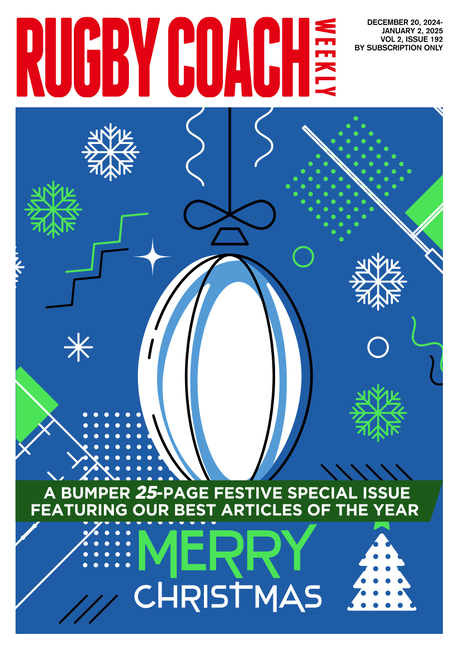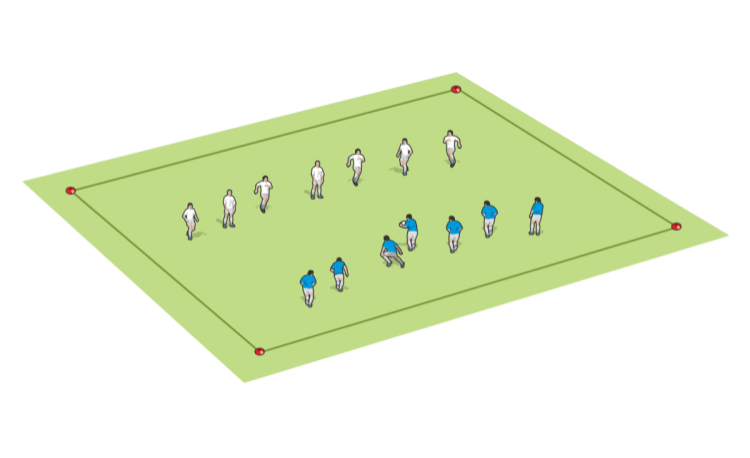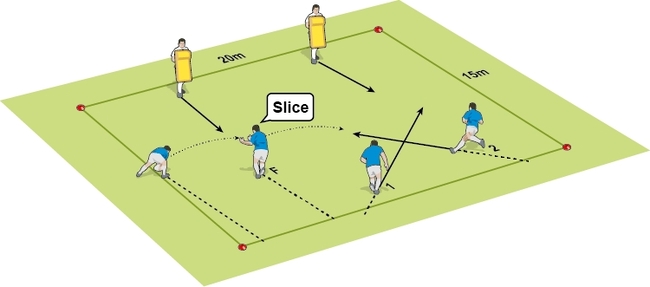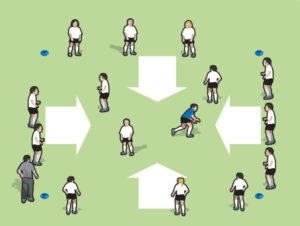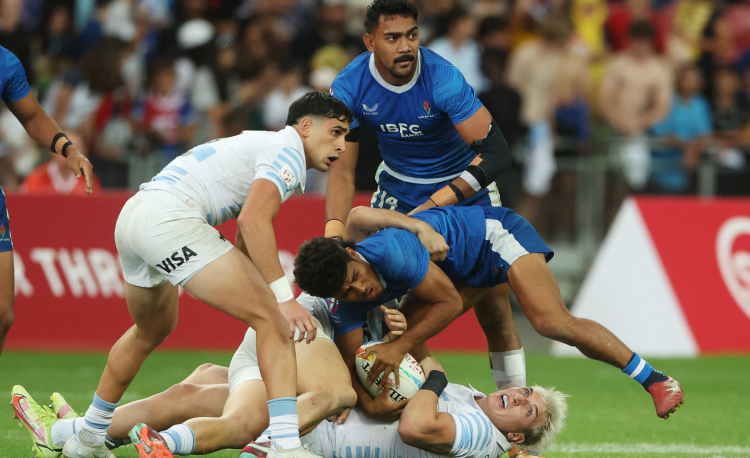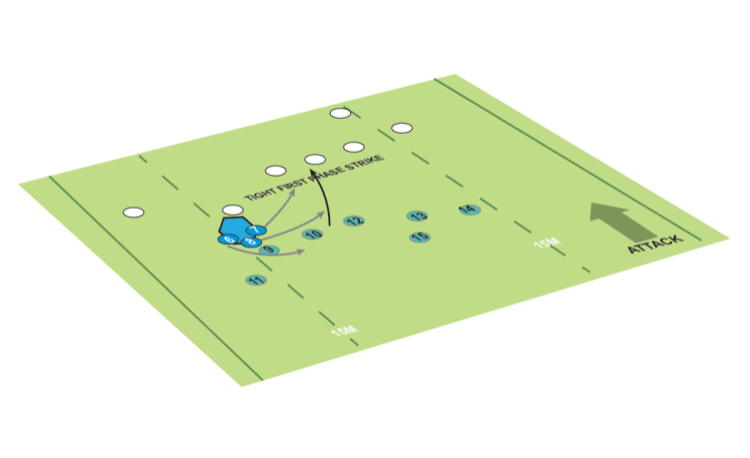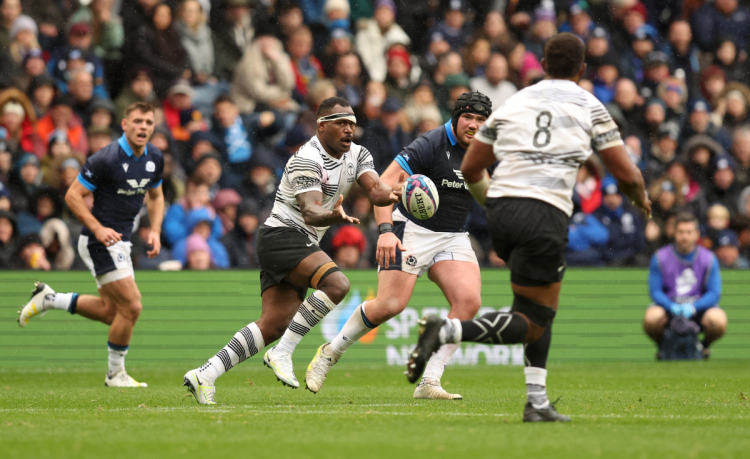A Covid-19 Tens game for all shapes and sizes
Small-Sided Gamesby Eamonn Hogan
Here is my version of Tens which should allow all your players in your squad to get the most out of the modified version of the game.

20-minute matches (2 x 10min)
Short 10 minute halves ensure a fast-paced game with multiple changes that all positions and body shapes can play to their own levels of fitness.
This modified version of the game also allows multiple teams within a club environment (male, female and senior XVs and also junior teams) to come together and play multiple games in one day while also ensuring the required social distancing measures as it relates to the levels put in place by the RFU (and other governing bodies).
Playing enclosure between 22m lines
A modified game usually results in fewer players exposed to a much larger playing area per player. This has resulted in many players (mostly those who play in the front five) feeling that their effectiveness as players is limited to the 15-a-side version.
Although there is more space available, the removal of significant depth from the equation allows a player the feel more comfortable. This, allied to the next Law variation, should bring those lower-numbered players back to club rugby that hasn’t returned to play Ready4Rugby or touch rugby variations allowed through Stage D guidelines
Ten players per team (15 in squad)
There must be five forwards and five backs on the pitch at any one time.
All five forwards must be known within the club as being forwards. All five backs must be known within the club as being backs.
At all times TWO players who are seen in your club as front-five forwards MUST be on the field of play.
Allows the 15 person squad to contain multiple front 5 forwards to allow for substitutions – a minimum of three.
Tackling is allowed but only 1 v 1
Below waist tackling, 1 v 1, is currently allowed in training under Stage D guidelines. Move this into game play.
Post tackle, the team in possession keeps the ball if it is placed and moved away from the tackle area within three seconds.
No breakdowns are allowed: The ball is placed by the tackled player and then remove their hands away from the ball unless passed off the floor. This allows the clearing passer to maintain their distance away from the players on the ground.
The team in possession keeps the ball UNLESS the referee feels the attack is "lacking ambition".
Lacking Ambition is subjective but we are trying to move the ball to create exciting, multi-skilled play. If a team decided, for example, to play one-out rugby (just one pass to a player coming onto the ball) for an extended period of time, the referee can simply call "TURNOVER" and hand the ball to the opposition.
When a tackle is made and if the referee is satisfied the attacking team is meeting the aims of the game, they shout "PLAY".
If the referee feels a team is not using their possession effectively, they shout "TURNOVER".
This allows the referees to be part of the solutions to the issues in the game and work with the coaching staff to grow the skills of all players.
NOTE: Referees at grassroots clubs are often coaches, so this allows a coach to manage the play they are seeing.
A try is worth three points
This feeds into the conversions rationale.
Conversions are worth up to 3 points
Once a player has scored a try, they have 30 seconds to decide which BOX they wish to kick from. The scorer attempts the kick.
Each box is worth a different points total dependent on its distance from the posts.
This adds a little more challenge to the game
Rolling replacements
Each player/coach can manage their own player replacements.
The players leaving the field do so via the nearest touchline to the play.
Their replacements sprint from behind the posts into the field of play
This encourages quick interchanges and improves communication effectiveness which can transfer to a full 15-a-side game once it returns post-Covid restrictions.
At all times, two players recognised within their club as front row forwards must be on the field of play. Their replacements must also be front row players.
Therefore, three of the 15 person squad must be front row forwards
Specially adapted 5-man scrums
A scrum in this game is placing five forwards in a manner where they need to be in close proximity allowing space for the backs to exploit should they wish.
It is not a scrum as we currently know it. All players involved in the scrum will be facing AWAY from their opponents.
Each player must be 2m away from themselves and the opposition
The game restarts with the hooker holding the ball. On the referee's call, the 9, standing a further 2m away from the second rows, receives a pass from the hooker and the game continues.
Should scrums be necessary near the try line, the referee will walk out 5m and form the scrum at a mark of their choosing – there is no requirement for extra field markings.
The ball passed in from the side to replace lineout
As mauling is not considered safe under current Covid restrictions, should a ball leave the field of play, the defending team retreat 5m, the ball is passed in field BUT the defence cannot move until the ball is caught by the receiver of the sideline pass.
This is to allow a second pass to move the attack further from the touchline and into open field
A player that takes a quick tap penalty, must run at space and not at a defender
To encourage quick play, a tap penalty is permitted but if that player then deliberately runs at the retreating defender in the hope of gaining extra yardage or pushing the referee for a yellow card, a penalty is awarded to the defending team.
Box kicks can take place but the kicking team cannot chase the kick until the ball is caught by, or attempted to be caught by, a receiving player
To remove the danger of face to face contact when two players challenge for the ball in the air, all box kicks can only be chased once the receiving team has made a play at the ball.
A ball that goes off the field or goes through the try zone results in a scrum from the point of the kick.
Kick passes/chip kicks/grubber kicks into space are rewarded if lead directly to a score
With ever-tightening defences, the skill of a kick pass is currently underutilised in the modern game. This modified version encourages a variety of kicks and rewards their successful usage but in a safe manner.
All kicks MUST be into space. If a kick is covered by a defender, that defender MUST be allowed to play the ball before a tackle occurs.
There are no 1 v 1 challenges for the ball allowed.
If a kick into space is picked up and a ball carrier scores immediately, that try is worth 5 points not 3 as it is for a normal try in this proposal.
If a kick goes into the try zone from a kick pass, the ball is deemed dead and the defence can bring the ball to their own 10m line to take a free kick. The free kick must be taken in line where the ball entered the try zone.
No try can be given from a kick into the try zone.
THE RULES

- 20-minute matches (2 x 10min)
- Playing enclosure between 22m lines
- Ten players per team (15 in the squad)
- Tackling is allowed but only 1 v 1
- A try is worth three points
- Conversions are worth up to 3 points
- Rolling replacements
- Specially adapted 5-man scrums
- The ball passed in from the side to replace lineout
- A player that takes a quick tap penalty, must run at space and not at a defender
- Box kicks can take place but the kicking team cannot chase the kick until the ball is caught by, or attempted to be caught by, a receiving player
- Kick passes/chip kicks/grubber kicks into space are rewarded if lead directly to a score
THE RATIONALE
20-minute matches (2 x 10min)
Short 10 minute halves ensure a fast-paced game with multiple changes that all positions and body shapes can play to their own levels of fitness.
This modified version of the game also allows multiple teams within a club environment (male, female and senior XVs and also junior teams) to come together and play multiple games in one day while also ensuring the required social distancing measures as it relates to the levels put in place by the RFU (and other governing bodies).
Playing enclosure between 22m lines
A modified game usually results in fewer players exposed to a much larger playing area per player. This has resulted in many players (mostly those who play in the front five) feeling that their effectiveness as players is limited to the 15-a-side version.
Although there is more space available, the removal of significant depth from the equation allows a player the feel more comfortable. This, allied to the next Law variation, should bring those lower-numbered players back to club rugby that hasn’t returned to play Ready4Rugby or touch rugby variations allowed through Stage D guidelines
Ten players per team (15 in squad)
There must be five forwards and five backs on the pitch at any one time.
All five forwards must be known within the club as being forwards. All five backs must be known within the club as being backs.
At all times TWO players who are seen in your club as front-five forwards MUST be on the field of play.
Allows the 15 person squad to contain multiple front 5 forwards to allow for substitutions – a minimum of three.
Tackling is allowed but only 1 v 1
Below waist tackling, 1 v 1, is currently allowed in training under Stage D guidelines. Move this into game play.
Post tackle, the team in possession keeps the ball if it is placed and moved away from the tackle area within three seconds.
No breakdowns are allowed: The ball is placed by the tackled player and then remove their hands away from the ball unless passed off the floor. This allows the clearing passer to maintain their distance away from the players on the ground.
The team in possession keeps the ball UNLESS the referee feels the attack is "lacking ambition".
Lacking Ambition is subjective but we are trying to move the ball to create exciting, multi-skilled play. If a team decided, for example, to play one-out rugby (just one pass to a player coming onto the ball) for an extended period of time, the referee can simply call "TURNOVER" and hand the ball to the opposition.
When a tackle is made and if the referee is satisfied the attacking team is meeting the aims of the game, they shout "PLAY".
If the referee feels a team is not using their possession effectively, they shout "TURNOVER".
This allows the referees to be part of the solutions to the issues in the game and work with the coaching staff to grow the skills of all players.
NOTE: Referees at grassroots clubs are often coaches, so this allows a coach to manage the play they are seeing.
A try is worth three points
This feeds into the conversions rationale.
Conversions are worth up to 3 points
Once a player has scored a try, they have 30 seconds to decide which BOX they wish to kick from. The scorer attempts the kick.
Each box is worth a different points total dependent on its distance from the posts.
This adds a little more challenge to the game
Rolling replacements
Each player/coach can manage their own player replacements.
The players leaving the field do so via the nearest touchline to the play.
Their replacements sprint from behind the posts into the field of play
This encourages quick interchanges and improves communication effectiveness which can transfer to a full 15-a-side game once it returns post-Covid restrictions.
At all times, two players recognised within their club as front row forwards must be on the field of play. Their replacements must also be front row players.
Therefore, three of the 15 person squad must be front row forwards
Specially adapted 5-man scrums
A scrum in this game is placing five forwards in a manner where they need to be in close proximity allowing space for the backs to exploit should they wish.
It is not a scrum as we currently know it. All players involved in the scrum will be facing AWAY from their opponents.
Each player must be 2m away from themselves and the opposition
The game restarts with the hooker holding the ball. On the referee's call, the 9, standing a further 2m away from the second rows, receives a pass from the hooker and the game continues.
Should scrums be necessary near the try line, the referee will walk out 5m and form the scrum at a mark of their choosing – there is no requirement for extra field markings.
The ball passed in from the side to replace lineout
As mauling is not considered safe under current Covid restrictions, should a ball leave the field of play, the defending team retreat 5m, the ball is passed in field BUT the defence cannot move until the ball is caught by the receiver of the sideline pass.
This is to allow a second pass to move the attack further from the touchline and into open field
A player that takes a quick tap penalty, must run at space and not at a defender
To encourage quick play, a tap penalty is permitted but if that player then deliberately runs at the retreating defender in the hope of gaining extra yardage or pushing the referee for a yellow card, a penalty is awarded to the defending team.
Box kicks can take place but the kicking team cannot chase the kick until the ball is caught by, or attempted to be caught by, a receiving player
To remove the danger of face to face contact when two players challenge for the ball in the air, all box kicks can only be chased once the receiving team has made a play at the ball.
A ball that goes off the field or goes through the try zone results in a scrum from the point of the kick.
Kick passes/chip kicks/grubber kicks into space are rewarded if lead directly to a score
With ever-tightening defences, the skill of a kick pass is currently underutilised in the modern game. This modified version encourages a variety of kicks and rewards their successful usage but in a safe manner.
All kicks MUST be into space. If a kick is covered by a defender, that defender MUST be allowed to play the ball before a tackle occurs.
There are no 1 v 1 challenges for the ball allowed.
If a kick into space is picked up and a ball carrier scores immediately, that try is worth 5 points not 3 as it is for a normal try in this proposal.
If a kick goes into the try zone from a kick pass, the ball is deemed dead and the defence can bring the ball to their own 10m line to take a free kick. The free kick must be taken in line where the ball entered the try zone.
No try can be given from a kick into the try zone.
Newsletter Sign Up
Coaches Testimonials

Gerald Kearney, Downtown Las Vegas Soccer Club

Paul Butler, Florida, USA

Rick Shields, Springboro, USA

Tony Green, Pierrefonds Titans, Quebec, Canada
Subscribe Today
Be a more effective, more successful rugby coach
In a recent survey 89% of subscribers said Rugby Coach Weekly makes them more confident, 91% said Rugby Coach Weekly makes them a more effective coach and 93% said Rugby Coach Weekly makes them more inspired.
Get Weekly Inspiration
All the latest techniques and approaches
Rugby Coach Weekly offers proven and easy to use rugby drills, coaching sessions, practice plans, small-sided games, warm-ups, training tips and advice.
We've been at the cutting edge of rugby coaching since we launched in 2005, creating resources for the grassroots youth coach, following best practice from around the world and insights from the professional game.


